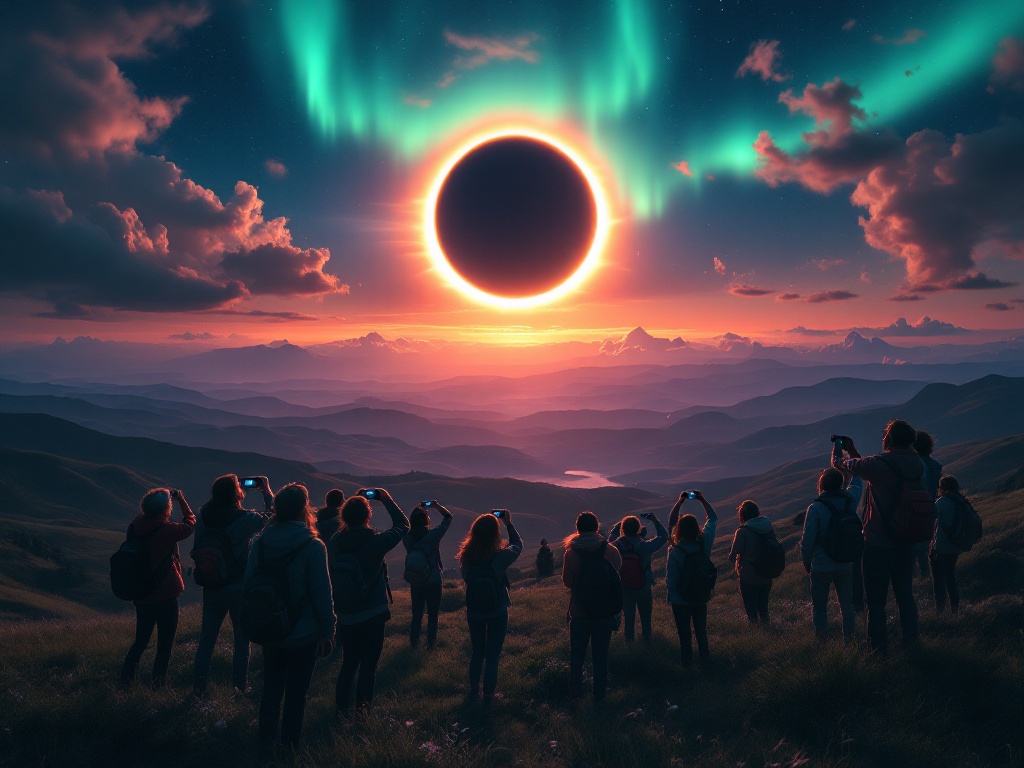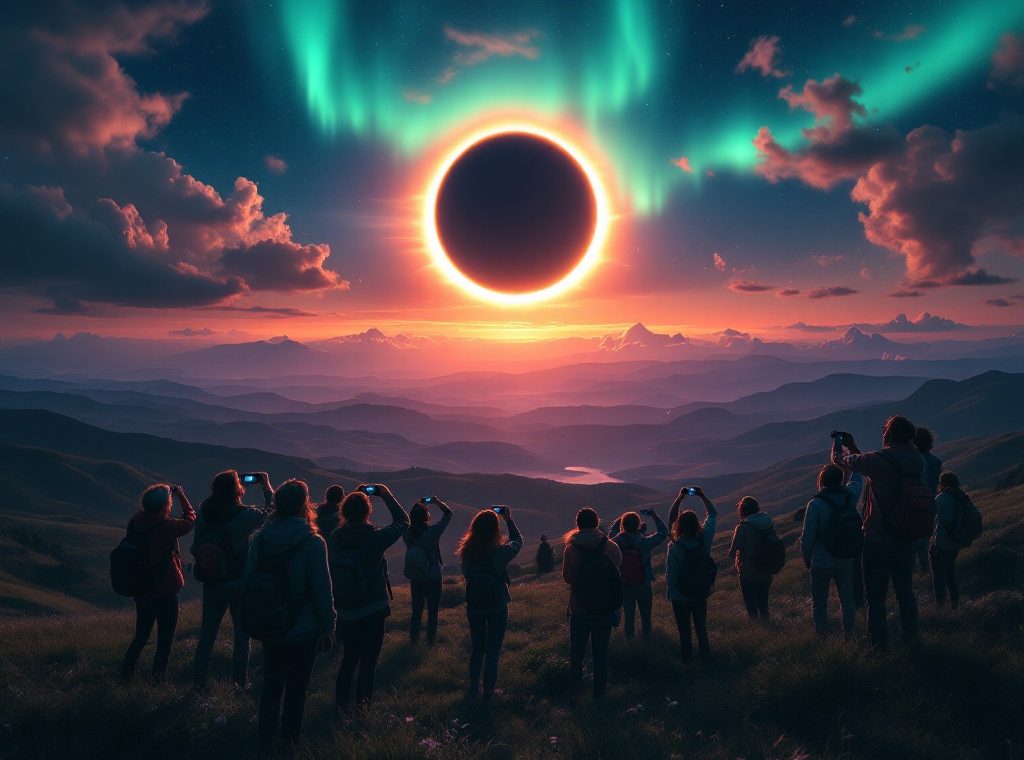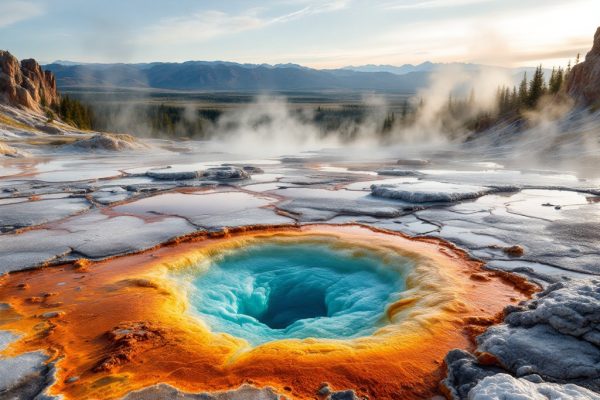Scientific Phenomena Tours: Chasing Solar Eclipses, Auroras, and More
Witness the breathtaking beauty of a total solar eclipse, the vibrant dance of the aurora borealis, or the dazzling spectacle of a meteor shower. Scientific phenomena tours offer expertly guided trips to prime locations, providing unparalleled opportunities to experience these incredible natural events. Learn from expert guides, capture stunning photos, and even contribute to scientific research through citizen science initiatives. Explore the science behind these phenomena while embarking on an unforgettable adventure. Discover the magic of our planet and start planning your extraordinary journey today!
Important information

- Scientific phenomena tours offer guided trips to witness events like solar eclipses, auroras, and meteor showers, providing expert insights into the science behind them.
- To safely view a solar eclipse, special ISO-compliant glasses are crucial to protect your eyes. Plan your trip in advance, considering the path of totality for the best experience.
- Auroras (Northern and Southern Lights) occur when charged solar particles interact with Earth’s atmosphere and magnetic field. Prime viewing locations are near the Arctic Circle, in places like Alaska, Canada, Norway, Sweden, and Finland.
- Engage in citizen science during your tour. Using apps like GLOBE Observer and Aurorasaurus, you can contribute valuable data to ongoing research while deepening your understanding of these phenomena.
- Photography tips are often included, allowing you to capture stunning images of these natural events. Key equipment includes DSLRs or mirrorless cameras, tripods, and various lenses.
Introduction to Scientific Phenomena Tours
Experience the thrill of scientific discovery with phenomena tours. These expertly crafted trips take you to extraordinary locations to witness awe-inspiring natural events. Observe breathtaking solar eclipses, vibrant auroras, and dazzling meteor showers. Expert guides accompany each tour, providing insights into the science behind these spectacular phenomena. Imagine exploring the Earth’s magnetic field while being mesmerized by the aurora borealis. Whether you’re a seasoned science enthusiast or simply curious about the world, these tours offer a unique and enriching experience.
Witness breathtaking events, such as solar eclipses, auroras, and meteor showers.
Learn from expert guides who explain the science behind the phenomena.
What Are Scientific Phenomena Tours?
Embark on a scientific phenomena tour and witness breathtaking natural events. Observe solar eclipses, auroras, and meteor showers, all while expert guides enrich the experience with scientific explanations. These unique tours combine travel and discovery, offering incredible educational opportunities. Imagine watching a meteor shower alongside an astronomer who explains the celestial spectacle unfolding before your eyes. These tours are more than just lectures; they’re immersive adventures. Many even provide photography tips, helping you capture stunning images of these remarkable events.
Witness breathtaking natural events such as solar eclipses, auroras, and meteor showers.
Learn from expert guides who provide scientific explanations, enriching the travel experience.
Enjoy immersive adventures that go beyond lectures, making learning an active experience.
Receive photography tips to capture stunning images of these remarkable events.
Why Choose Scientific Phenomena Tours?
Embark on a phenomenal tour for an immersive scientific experience. Led by expert guides, these curated trips offer prime viewing locations and in-depth explanations, enhancing your understanding and appreciation of incredible natural events. Discover the science behind these phenomena through this unique opportunity.
Chasing Solar Eclipses: A Unique Experience
A total solar eclipse is a spectacular celestial event that occurs when the Moon passes between the Sun and Earth, completely obscuring the Sun’s light. This temporary darkness reveals the Sun’s corona, a breathtaking sight. The path of totality, a narrow strip where the Moon’s shadow fully covers the Sun, offers the best viewing experience. Outside this path, observers witness a partial eclipse.
North America will experience a total solar eclipse on April 8, 2024.
On August 12, 2026, the eclipse will traverse the Atlantic, reaching Spain, Iceland, and Greenland.
The following year, on August 2, 2027, it will be visible across the Atlantic, North Africa, and the Middle East.
Finally, on July 22, 2028, Australia, New Zealand, and the surrounding oceans will have their turn.
Safe viewing is paramount. Special eclipse glasses are essential to protect your eyes from harmful solar radiation. Never look directly at the Sun without them.
For optimal viewing, plan your trip well in advance. Book accommodations and transportation early, especially for popular locations. Research local weather forecasts, as clear skies are essential. Pack for various weather conditions to ensure a comfortable and memorable experience.
What is a Total Solar Eclipse?
A total solar eclipse is a stunning celestial event where the moon completely obscures the sun, revealing the breathtaking sight of its corona.
The Path of Totality: Where to Witness the Magic
To witness a total solar eclipse, you must be within the path of totality—the narrow band where the moon completely obscures the sun. Millions experienced this breathtaking phenomenon during the 2017 eclipse, which crossed the US. Anyone planning a trip to see an eclipse should carefully research the path’s location; it’s the key to the full experience.
Upcoming Total Solar Eclipse Dates
Get ready! A total solar eclipse will grace the skies on April 8, 2024. Another opportunity to witness this spectacular phenomenon follows soon after, on August 12, 2026.
Eclipse Viewing: Essential Gear and Tips
Viewing the eclipse safely requires special glasses, as directly looking at the sun can damage your eyes. Protecting your eyes is crucial. For the best viewing experience, plan the timing and location carefully. Check the weather forecast and ensure your chosen spot is accessible. Remember essentials like water, snacks, and comfortable clothing. A camera and tripod can help capture the event, but don’t forget to savor the experience.
Protect your eyes with special glasses. Never look directly at the sun.
Plan the timing and location. Check the weather forecast and accessibility of your viewing spot.
Pack essentials. Bring water, snacks, and wear comfortable clothing.
Consider bringing a camera and tripod to document the eclipse.
Most importantly, enjoy the unique experience.
Eclipse Logistics and Planning Your Trip
Planning for an eclipse? Here’s how to make the most of it:
Book accommodations and transportation early. These fill up quickly due to high demand.
Choose a viewing spot within the path of totality for the full eclipse experience.
Research historical weather patterns for your chosen location to increase your chances of clear skies.
Don’t forget your ISO-compliant solar viewing glasses for safe observation.
Auroras: Nature’s Vibrant Light Displays
Auroras, also known as the Northern Lights (Aurora Borealis) in the northern hemisphere and Southern Lights (Aurora Australis) in the south, are a stunning natural display. This breathtaking phenomenon occurs when charged particles from the sun, carried on solar winds, interact with Earth’s magnetic field and atmosphere. Upon colliding with atmospheric gases like oxygen and nitrogen, these particles energize the gases, causing them to emit light and create vibrant colors. Oxygen typically produces green and red auroras, while nitrogen contributes blue and purple hues.
Auroral Colors
- Oxygen: Creates














